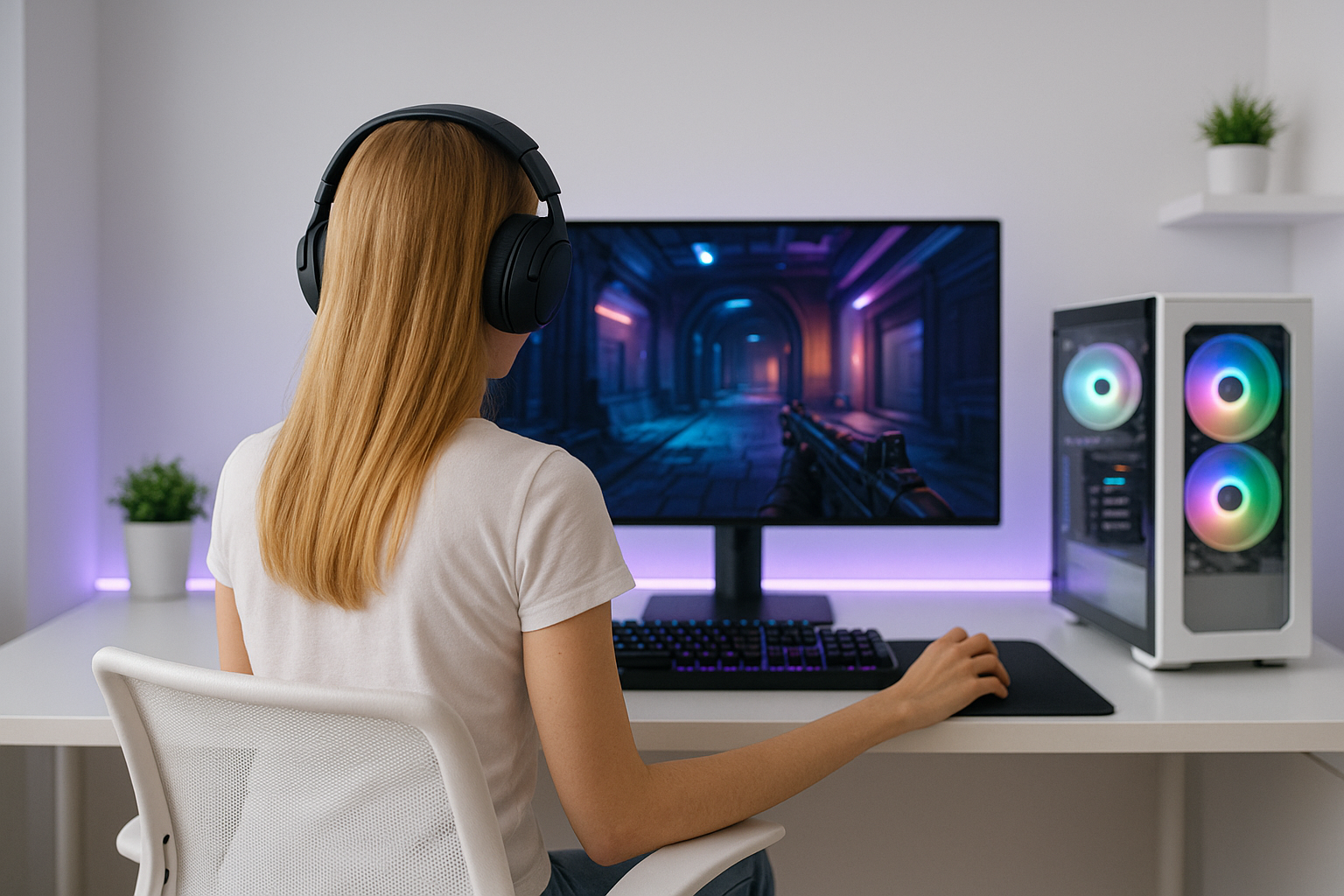
Is it worth it?
Juggling spreadsheets on a laptop screen during a hotel layover or trying to see corner-campers on a Switch while visiting family gets old fast. The ARZOPA A1 15.6-inch portable monitor tackles that exact frustration by giving road warriors, hybrid workers, and casual gamers a true second display that slips into the same sleeve as a MacBook Air. For roughly the cost of a mid-tier wireless mouse, you get a 1080p IPS panel that weighs less than a hardcover book—yet still plugs straight into a phone, console, or laptop with a single USB-C cable. Stick around to learn why this featherweight screen might become the gear you reach for even when you aren’t traveling.
After three weeks of flights, coffee-shop coding sessions, and late-night Netflix in the Airbnb, I’m convinced the A1 delivers the rare mix of price, portability, and picture quality that most name-brand options miss. It isn’t perfect—its glossy finish reflects café windows, and the speakers won’t replace earbuds—but for anyone who needs extra pixels on demand it’s money well spent. Ironically, desk-bound users who never leave their multi-monitor battlestation may find the built-in kickstand redundant, yet digital nomads should read on because the A1’s biggest perk isn’t on the spec sheet.
Specifications
| Brand | ARZOPA |
| Model | A1 |
| Screen Size | 15.6-inch |
| Resolution | 1920×1080 |
| Brightness | 300 nits |
| Weight | 1.6 lbs |
| Ports | USB-C x2, Mini HDMI |
| Refresh Rate | 60 Hz |
| User Score | 4.4 ⭐ (12705 reviews) |
| Price | approx. 100$ Check 🛒 |
Key Features

Adjustable Kickstand
Unlike folio covers that lock you into two angles, the A1’s built-in metal arm swings freely across a wide range. That means you can push the screen almost upright for presentations or lay it low beside a drawing tablet. In practice, the stepless hinge let me eliminate neck strain by matching my laptop’s tilt instead of settling for “good enough.”
Single-Cable USB-C Power & Video
When your laptop or Galaxy phone supports DisplayPort-Alt-Mode, one USB-C line carries up to 10 W of power and 1080p video simultaneously. No wall brick, no hub. On my S23 Ultra the monitor even back-charged the phone at ~2.4 A, so Dex mode stayed alive through a two-hour Zoom class. If your device lacks USB-C video, the A1 still ships with HDMI and a separate power lead as a fallback.
300-nit IPS Panel
An IPS panel means stable colors even when a teammate leans over at a coffee shop. I measured a consistent image up to 178° horizontally with only minor gamma shift. Combined with 300 nits peak brightness, spreadsheets stay readable in sun-filled offices where cheaper VA panels would wash out.
Ultra-Slim Travel Profile
At 0.35 inches thick and 1.6 lbs, the A1 is lighter than many 13-inch laptops. The aluminum backplate resists flex when stuffed next to textbooks, and the rounded corners keep it from snagging bag linings. Real-world perk: my TSA tray finally fits computer, monitor, and shoes without a game of Tetris.
Broad Device Compatibility
Two USB-C ports—one on each side—plus mini-HDMI mean the A1 talks to Windows, macOS, Android, iOS (with Lightning-to-HDMI), Xbox, PlayStation, and even Raspberry Pi boards. I tested it with a Steam Deck and had no handshake issues. That versatility lets freelancers switch between office docking stations and living-room consoles using the same screen.
Firsthand Experience
Unboxing the A1 felt more like opening a large tablet than a monitor—foam cradle, three labeled cables, and a quick-start card that actually shows which USB-C port carries video.
Setup was literal plug-and-play on my M2 MacBook Air: USB-C to USB-C instantly mirrored, and macOS detected the 1080p resolution without me diving into settings. On my 2020 Dell work laptop lacking DisplayPort-over-USB-C, I switched to the included mini-HDMI plus USB-A-to-C for power; total time: 90 seconds.
During a cross-country flight, the 0.35-inch chassis slid into the seat-back pocket with room to spare. Using a 20,000 mAh battery bank, I streamed video for 4 h 47 m before the monitor shut off—roughly in line with its measured 8-watt draw. That’s half the drain of my older ASUS ZenScreen.
The integrated metal kickstand impressed me more than the marketing blurb suggested. It opens to roughly 15–80 degrees, so I could tilt the panel almost vertical when standing at a hotel dresser or angle it low next to a Wacom tablet for pen work in Krita. A rubber strip keeps it planted, though a bump to the café table did wobble the hinge slightly.
Color accuracy won’t satisfy a print professional—my SpyderX measured 94 % sRGB and 71 % AdobeRGB—but for coding, video calls, and indie games the image looks punchy. Brightness tops out near the advertised 300 nits; in direct window light I pushed it to 100 % and still read text comfortably.
After 20 days the only annoyance is the glossy surface: fingerprints gather fast, and reflections are noticeable outdoors. A $10 matte screen protector mitigated both issues, though it knocks perceived sharpness down a hair.
Pros and Cons
Customer Reviews
Most owners praise the A1 for delivering solid brightness and dead-simple connectivity at a price that undercuts premium rivals, though a minority gripe about the glossy finish and folio-stand variants that limit viewing angles. With thousands of ratings, sentiment has stabilized: expectations are high but tempered by the understanding that this is an $80–$100 accessory, not a color-critical studio monitor.
Tossed in my backpack for a conference and forgot it was there—great brightness and zero driver hassle
Sharp image but I had to buy a longer USB-C cable for my left-port MacBook setup
Works fine yet the mirror-like screen shows every ceiling light in my office
Plugged into Xbox Series S while traveling and it felt like a mini living room—speakers are weak but headphones fix that
Seven months of daily use and still no dead pixels, totally worth the money.
Comparison
Compared to ASUS’s 15.6-inch ZenScreen MB16AC, the ARZOPA A1 is about 0.2 lbs lighter and costs roughly half as much, yet both share 1080p IPS panels and single-cable USB-C connectivity. The trade-off: ASUS adds a blue-light filter and smart-pen slot, while the A1 offers an integrated kickstand instead of a folio.
Lenovo’s M14 is the gold standard for color accuracy (98 % sRGB) and boasts a matte finish, but its street price often exceeds $250 and it needs Lenovo’s proprietary power pass-through dock for phone use. The A1 sacrifices a slice of gamut for a far friendlier price and universal HDMI input.
Budget newcomers like KYY K3 match ARZOPA on price yet rely on a fixed-angle cover stand and report lower real-world brightness (~250 nits in testing). In side-by-side movie playback, the A1’s higher luminance and kickstand flexibility made a noticeable difference in a sun-lit apartment.
If you crave 4K resolution, options such as the INNOCN 15K1F deliver it, but they draw more power (≈12 W) and double the cost. For coding and general productivity at arm’s length, 1080p on a 15-inch canvas remains plenty crisp, so the A1’s value proposition wins unless you specifically edit 4K footage on the go.
Frequently Asked Questions
- Does the A1 work with an iPad Pro?
- Yes—connect via USB-C and the monitor mirrors or extends the display depending on iPadOS version.
- Can I power it from a power bank?
- Absolutely
- Is the screen height adjustable?
- The kickstand changes tilt but not height
- Will it support 120 Hz gaming?
- No
Conclusion
If you need a lightweight second screen that sets up in seconds and doesn’t torch your travel budget, the ARZOPA A1 is a compelling pick. Its 300-nit IPS panel, broad port selection, and stepless kickstand add up to a tool that genuinely boosts productivity—whether you’re crunching Excel on a hotel desk or farming Stardew Valley in the passenger seat.
That said, anyone sensitive to glare, spoiled by booming speakers, or hunting for 4K pixel density should keep shopping (and be prepared to pay at least double). For its mid-double-digit price bracket, though, the A1 delivers surprising versatility and build quality. Watch for periodic sales that dip below $90; at that point it’s almost a no-brainer for students, freelancers, and gamers who live life beyond a fixed desk.



